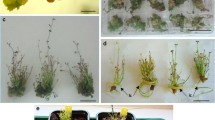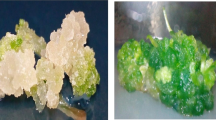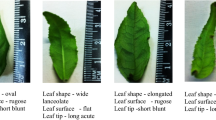Abstract
The genus Lathyrus includes a number of neglected wild relatives of pea with potential as genetic resources for acquisition of stress resistance traits, but, due to little breeding, genotypes under culture are mainly landraces and seldom true varieties. Development of in vitro approaches for Lathyrus is also limited, and assessments of nuclear DNA content, for taxonomical or breeding purposes, are sparse. Genome size and AT/GC ratio were determined by flow cytometry, allowing for distinction between protein and forage L. sativus, L. cicera, L. ochrus and L. clymenum and the ornamental sweet pea (L. odoratus), and also between landraces within L. sativus L. and L. cicera L. In addition, explants from in vitro seedlings of eight genotypes from the five Lathyrus species above were cultivated in vitro, plant regeneration was achieved for all landraces and species, and the nuclear DNA content of the regenerants was compared with that of their mother plants, whereby the true-to-typeness of such regenerants was confirmed.





Similar content being viewed by others
References
Ali HBM, Meister A, Schubert I (2000) DNA content, rDNA loci, and DAPI bands reflect the phylogenetic distance between Lathyrus species. Genome 43:1027–1032
Arumuganathan K, Earle ED (1991) Nuclear DNA content of some important plant species. Plant Mol Biol Rep 9:208–218
Baranyi M, Greilhuber J (1995) Flow cytometric analysis of genome size variation in cultivated and wild Pisum sativum L. (Fabaceae). Plant Syst Evol 194:231–239
Baranyi M, Greilhububer J (1996) Flow cytometric and feulgen densitometric analysis of genome size variation in Pisum. Theor Appl Genet 92:297–307
Baranyi M, Greilhuber J, Swiecicki WK (1996) Genome size in wild Pisum species. Theor Appl Genet 93:717–721
Barik DP, Mohapatra U, Chand PK (2005) Transgenic grasspea (Lathyrus sativus L.): factors influencing Agrobacterium-mediated transformation and regeneration. Plant Cell Rep 24:523–531
Barow M, Meister A (2002) Lack of correlation between AT frequency and genome size in higher plants and the effect of nonrandomness of base sequences on dye binding. Cytom A 47:1–7
Bennett MD, Leitch IJ (2005) Nuclear DNA amounts in angiosperms: progress, problems and prospects. Ann Bot 95:45–90
Bennett MD, Smith JB (1976) Nuclear DNA amounts in angiosperms. Phil Trans R Soc Lond Ser B-Biol Sci 274:227–274
Biswas AK (2007) Induced mutation in grasspea (Lathyrus sativus L.). In: Ochatt SJ, Jain SM (eds) Breeding of neglected and under-utilised crops, spices and herbs. Science, Plymouth, pp 29–40
Chaudhury D, Das A (1988) X-irradiation induced biochemical changes in the seeds of L. sativus. Indian Biol 20:30–35
Doležel J, Sgorbati S, Lucretti S (1992) Comparison of three DNA fluorochromes for flow cytometric estimation of nuclear DNA content in plants. Physiol Plant 85:625–631
Doležel J, Bartoš J, Voglmayr H, Greilhuber J (2003) Nuclear DNA content and genome size of trout and human. Cytom A 51:127–128
Doležel J, Greilhuber J, Suda J (eds) (2007) Flow cytometry with plant cells. Analysis of genes, chromosomes and genomes. Wiley-VCH Verlag, Weinheim. P.455. ISBN: 978-3-527-31487-4
Doležel J, Greilhuber J, Suda J (2007b) Flow cytometry with plants: an overview. In: Greilhuber J, Suda J, Dolezel J (eds) Flow cytometry with plant cells. Wiley-VCH Verlag, Weinheim, pp 41–60
Durieu P, Ochatt SJ (2000) Efficient intergeneric protoplast fusion between pea (Pisum sativum L.) and grass pea (Lathyrus sativus L.). J Exp Bot 51:1237–1242
Elmaghrabi A, Ochatt S (2006) Isoenzymes and flow cytometry for the assessment of true-to-typeness of calluses and cell suspensions of barrel medic prior to regeneration. Plant Cell Tissue Organ Cult 85:31–43
Galbraith DW, Bartos J, Dolezel J (2005) Flow cytometry and cell sorting in plant biotechnology. In: Sklar LA (ed) Flow Cytometry for Biotechnology. Oxford University Press, Oxford, pp 291–322
Gamborg OL, Miller RA, Ojima K (1968) Nutrient requirements of suspension cultures of soybean root cells. Exp Cell Res 50:151–158
Godelle B, Cartier D, Marie D, Brown SC, Siljak-Yakovlev S (1993) Heterochromatin study demonstrating the non-linearity of fluorometry useful for calculating genomic base composition. Cytometry 14:618–626
Greilhuber J, Doležel J, Lysàk MA, Bennett MD (2005) The origin, evolution and proposed stabilization of the terms ‘genome size’ and ‘C-value’ to describe nuclear DNA contents. Ann Bot 95:255–260
Greilhuber J, Temsch EM, Loureiro JCM (2007) Nuclear DNA content measurement. In: Dolezel J, Greilhuber J, Suda J (eds) Flow cytometry with plant cells. Wiley-VCH Verlag, Weinheim, pp 67–102
Heller FO (1973) DNA Measurement of Vicia faba L. with the pulse cytophotometry. Ber Dtsch Bot Gesellschaft 86:437–441
Hutchinson J, Narayan RKJ, Rees H (1980) Constraints upon the composition of supplementary DNA. Chromosoma 78:37–145
Kapuscinski J (1995) DAPI: a DNA-specific fluorescent probe. Biotechnol Histochem 70:220–233
Koné M, Patat-Ochatt EM, Conreux C, Sangwan RS, Ochatt SJ (2007) In vitro morphogenesis from cotyledon and epicotyl explants and flow cytometry distinction between landraces of Bambara groundnut [Vigna subterranea (L.) Verdc] an underutilised grain legume. Plant Cell Tiss Organ Cult 88:61–75
Lambein F, Kuo YH (2004) Somaclonale variatie in Lathyrus sativus. In: Abstracts, autumn meeting Netherlands Society for plant biotechnology and tissue culture NVPW, Leiden. http://www.nvpw.nl/pdf/NVPW04-2.pdf. Accessed 20 Sep 2010
Leitch IJ, Bennett MD (2007) Genome size and its uses: the impact of flow cytometry. In: Dolezel J, Greilhuber J, Suda J (eds) Flow cytometry with plant cells. Wiley-VCH Verlag, Weinheim, pp 153–176
Marie D, Brown SC (1993) A cytometric exercise in plant DNA histograms, with 2C values for 70 species. Biol Cell 78:41–51
Mc Ilvaine TC (1921) A buffer solution for colorimetric comparison. J Biol Chem 49:183–186
McCutchan JS, Larkin PJ, Stoutjesdijk PA, Morgan ER, Taylor PWJ (1999) Establishment of shoot and suspension cultures for protoplast isolation in Lathyrus sativus L. J Breed Genet 31:43–50
Mehta SL (1997) Plant biotechnology for removal of ODAP from Lathyrus. In: Haimanot RT, Lambein F (eds) Lathyrus and lathyrism, a decade of progress. University of Ghent, Ghent, pp 103–104
Meister A, Barow M (2007) DNA base composition of plant genomes. In: Dolezel J, Greilhuber J, Suda J (eds) Flow cytometry with plant cells. Wiley-VCH Verlag, Weinheim, pp 177–215
Murashige T, Skoog F (1962) A revised medium for rapid growth and bioassays with tobacco tissue cultures. Physiol Plant 15:473–497
Murray BG, Hammett KRW, Standring LS (1992) Genomic constancy during the development of Lathyrus odoratus cultivars. Heredity 68:321–327
Nagl W, Jeanjour M, Kling H, Kuhner S, Michels I, Muller T, Stein B (1983) Genome and chromatin organization in higher plants. Biol Zentralblatt 102:129–148
Nandini AV, Murray BG, O’Brien IEW, Hammett KRW (1997) Intra- and interspecific variation in genome size in Lathyrus (Leguminosae). Bot J Linn Soc 25:359–366
Narayan RKJ (1982) Discontinuous DNA variation in the evolution of plant species—the genus Lathyrus. Evolution 36:877–891
Narayan RKJ, Rees H (1976) Nuclear DNA variation in Lathyrus. Chromosoma 54:141–154
Nerkar YS (1972) Induced variation and responses to selection for low neurotoxin content in Lathyrus sativus. Indian J Genet Plant Breed 32:175–180
Nerkar YS (1976) Mutation studies in Lathyrus sativus. Indian J Genet Plant Breed 36:223–229
Ochatt SJ (2008) Flow cytometry in plant breeding. Cytom A 73:581–598
Ochatt SJ, Pontécaille C, Rancillac M (2000) The growth regulators used for bud regeneration and shoot rooting affect the competence for flowering and seed set in regenerated plants of protein pea. In Vitro Cell Dev Biol–Plants 36:188–193
Ochatt S, Durieu P, Jacas L, Pontécaille C (2001) Protoplast, cell and tissue cultures for the biotechnological breeding of grass peas. Lathyrus Neurolathyrism Newslett 2:35–38
Ochatt SJ, Muneaux E, Machado C, Jacas L, Pontécaille C (2002a) The hyperhydricity of in vitro regenerants is linked with an abnormal DNA content in grass pea (Lathyrus sativus L.). J Plant Physiol 159:1021–1028
Ochatt SJ, Sangwan RS, Marget P, Assoumou Ndong Y, Rancillac M, Perney P (2002b) New approaches towards the shortening of generation cycles for faster breeding of protein legumes. Plant Breed 121:436–440
Ochatt SJ, Abirached-Darmency M, Marget P, Aubert G (2007) The Lathyrus paradox: “poor men’s diet” or a remarkable genetic resource for protein legume breeding? In: Ochatt SJ, Jain SM (eds) Breeding of neglected and under-utilised crops, spices and herbs. Science, Plymouth, pp 41–60
Ochatt S, Pech C, Grewal R, Conreux C, Lülsdorf M, Jacas L (2009) Abiotic stress enhances androgenesis from isolated microspores of some legume species (Fabaceae). J Plant Physiol 166:1314–1328
Ochatt SJ, Conreux C, Jacas L (2010) In vitro production of sweet peas (Lathyrus odoratus L.) via axillary shoots. In: Jain SM, Ochatt SJ (eds) Protocols for in vitro propagation of ornamental plants. Humana Springer, New Jersey, pp 293–301
Olszewska MJ, Osiecka R (1983) The relationship between 2C DNA content, life-cycle type, systematic position and the dynamics of DNA endoreplication inparenchyma nuclei during growth and differentiation of roots in somedicotyledonous-herbaceous species. Biochem Physiol Pflanzen 178:581–599
Razdan MK, Cocking EC, Power JB (1980) Callus regeneration from mesophyll protoplasts of sweet pea (Lathyrus odoratus L.). Z Pflanzenphysiol 96:181–183
Rees H, Hazarika MH (1969) Chromosome evolution in Lathyrus. Chromosom Today 2:158–165
Roy PK, Ali K, Gupta A, Barat GK, Mehta SL (1993) β-Noxalyl-L-α,β-diaminopropionic acid in somaclones derived from internode explants of Lathyrus sativus. J Plant Biochem Biotechnol 2:9–13
Rybínski W (2003) Mutagenesis as a tool for improvement of traits in grasspea (Lathyrus sativus L.). Lathyrus Lathyrism Newslett 3:27–31
Unal F, Callow RS (1995) Estimation of genome size by Feulgen photometry. Turkish J Bot 19:523–529
Vaz Patto MC, Skiba B, Pang ECK, Ochatt SJ, Lambein F, Rubiales D (2006) Lathyrus improvement for resistance against biotic and abiotic stresses: from classical breeding to marker assisted selection. Euphytica 147:133–147
Vaz Patto MC, Hanbury CD, van Moorhem M, Lambein F, Ochatt S, Rubiales D (2011) Grass pea. In: de la Vega MP, Torres AM, Cubero JI, Kole C (eds) Genetics, genomics and breeding of cool season grain legumes. Science, Lebanon, pp 151–204
Vinogradov AE (1994) Measurement by flow cytometry of genomic AT/GC ratio and genome size. Cytom A 16:34–40
Zambre M, Chowdhury B, Kuo YH, van Montagu M, Angenon G, Lambein F (2002) Prolific regeneration of fertile plants from green nodular callus induced from meristematic tissues in Lathyrus sativus L. (grass pea). Plant Sci 163:1107–1112
Author information
Authors and Affiliations
Corresponding author
Rights and permissions
About this article
Cite this article
Ochatt, S.J., Conreux, C. & Jacas, L. Flow cytometry distinction between species and between landraces within Lathyrus species and assessment of true-to-typeness of in vitro regenerants. Plant Syst Evol 299, 75–85 (2013). https://doi.org/10.1007/s00606-012-0704-7
Received:
Accepted:
Published:
Issue Date:
DOI: https://doi.org/10.1007/s00606-012-0704-7




